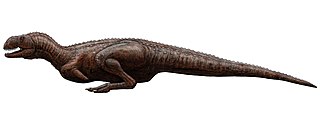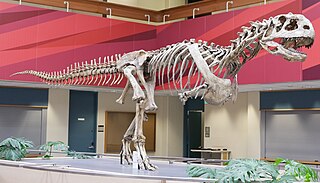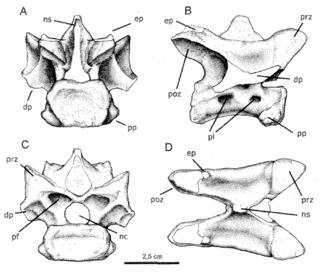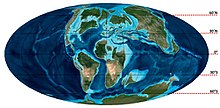
Rajasaurus is a genus of carnivorous abelisaurid theropod dinosaur from the Late Cretaceous of India, containing one species: Rajasaurus narmadensis. The bones were excavated from the Lameta Formation in the Gujarat state of Western India, probably inhabiting what is now the Narmada River Valley. It was formally described by palaeontologist Jeffrey A. Wilson and colleagues in 2003 based on a partial skeleton comprising the braincase, spine, hip bone, legs, and tail–a first for an Indian theropod. The dinosaur likely measured 6.6 metres (22 ft), and had a single horn on the forehead which was probably used for display and head-butting. Like other abelisaurids, Rajasaurus was probably an ambush predator.

Indosuchus is a genus of abelisaurid dinosaur from the Late Cretaceous Period, a theropod related to Abelisaurus. Like most theropods, Indosuchus was a bipedal carnivore. It was about 7 metres long, weighed about 1.2 tonnes, and had a crested skull, flattened on the top.

Abelisauridae is a family of ceratosaurian theropod dinosaurs. Abelisaurids thrived during the Cretaceous period, on the ancient southern supercontinent of Gondwana, and today their fossil remains are found on the modern continents of Africa and South America, as well as on the Indian subcontinent and the island of Madagascar. Isolated teeth were found in the Late Jurassic of Portugal, and the Late Cretaceous genera Tarascosaurus and Arcovenator have been described in France. Abelisaurids first appear in the fossil record of the early middle Jurassic period, and at least three genera survived until the end of the Mesozoic era 66 million years ago.

Aucasaurus is a genus of medium-sized abelisaurid theropod dinosaur from Argentina that lived during the Late Cretaceous of the Anacleto Formation. It was smaller than the related Carnotaurus, although more derived in some ways, such as its extremely reduced arms and almost total lack of fingers. The type skeleton is complete to the thirteenth caudal vertebra, and so is relatively well understood, and is the most complete abelisaurid yet described. However, the skull is damaged, causing some paleontologists to speculate that it was involved in a fight prior to death.

Abelisauroidea is a diverse superfamily of ceratosaurian dinosaurs, typically regarded as a Cretaceous group, though the earliest abelisaurid remains are known from the Middle Jurassic of Argentina and possibly Madagascar. Possible Abelisauridae remains were also discovered in Late Jurassic Tendaguru Beds in Tanzania.

Ilokelesia is an extinct genus of abelisaurid theropod, preserved in the layers of the earliest Late Cretaceous of the Huincul Formation, Neuquén Group, located near Plaza Huincul, Neuquén Province, Argentina. The specimen, consisting of very fragmentary elements of the skull and the axial and appendicular skeleton, was described by Rodolfo Coria and Leonardo Salgado in late 1998.

Quilmesaurus is a genus of carnivorous abelisaurid theropod dinosaur from the Patagonian Upper Cretaceous of Argentina. It was a member of Abelisauridae, closely related to genera such as Carnotaurus. The only known remains of this genus are leg bones which share certain similarities to a variety of abelisaurids. However, these bones lack unique features, which may render Quilmesaurus a nomen vanum.

Indosaurus is a genus of carnivorous theropod dinosaur that lived in what is now India, about 69 to 66 million years ago during the Maastrichtian division of the Late Cretaceous.

Compsosuchus is a dubious genus of abelisauroid dinosaur from the Late Cretaceous Lameta Formation of India.

Isisaurus is a genus of titanosaurian dinosaur from the Late Cretaceous Lameta Formation of India and Pab Formation of Pakistan. The genus contains a single species, Isisaurus colberti.

Majungasaurus is a genus of abelisaurid theropod dinosaur that lived in Madagascar from 70 to 66 million years ago, at the end of the Cretaceous Period, making it one of the last-known non-avian dinosaurs that went extinct during the Cretaceous–Paleogene extinction event. The genus contains a single species, Majungasaurus crenatissimus. This dinosaur is also called Majungatholus, a name which is considered a junior synonym of Majungasaurus.

Ekrixinatosaurus is a genus of abelisaurid theropod which lived approximately 100 to 97 million years ago during the Late Cretaceous period. Its fossils have been found in Argentina. Only one species is currently recognized, Ekrixinatosaurus novasi, from which the specific name honors of Dr. Fernando Novas for his contributions to the study of abelisaurid theropods, while the genus name refers to the dynamiting of the holotype specimen. It was a large abelisaur, measuring between 6.5 and 8 m in length and weighing 800 kg (1,800 lb).

Laevisuchus is a genus of theropod dinosaur from the Late Cretaceous. Its remains were discovered by Charles Alfred Matley near Jabalpur in Maastrichtian "Carnosaur Bed" deposits in the Lameta Formation in Madhya Pradesh, central India, and were named and described by paleontologists Friedrich von Huene and Matley in 1933.

Lametasaurus named for the Lameta Formation, Jabalpur, India, is the generic name given to a possibly chimeric dinosaur species. The type species is L. indicus.

The Lameta Formation, also known as the Infratrappean Beds, is a sedimentary geological formation found in Madhya Pradesh, Gujarat, Maharashtra, Telangana, and Andhra Pradesh, India, associated with the Deccan Traps. It is of the Maastrichtian age, and is notable for its dinosaur fossils

Austrocheirus is an extinct genus of theropod dinosaur that lived during the Late Cretaceous period. It was named and described by Martin Ezcurra, Federico Agnolin and Fernando Novas in 2010. It contains the type species Austrocheirus isasii. The generic name means "southern hand". The specific epithet honours discoverer and preparator Marcelo Pablo Isasi.

Arcovenator is an extinct genus of abelisaurid theropod dinosaurs hailing from the Late Cretaceous of France. The type and only described species is Arcovenator escotae.

Majungasaurinae is a subfamily of large carnivorous theropods from the Upper Cretaceous, found in Madagascar, India, and France. It is a subgroup within the theropod family Abelisauridae, a Gondwanan clade known for their thick and often horned skulls and vestigial arms. The two subfamilies of Abelisauridae are Carnotaurinae, best known from the South American Carnotaurus, and Majungasaurinae, consisting of Madagascar’s Majungasaurus and its closest relatives. Their ancestors emerged in the Middle Jurassic, and the clade lasted until the Upper Cretaceous.

This timeline of ceratosaur research is a chronological listing of events in the history of paleontology focused on the ceratosaurs, a group of relatively primitive, often horned, predatory theropod dinosaurs that became the apex predators of the southern hemisphere during the Late Cretaceous. The nature and taxonomic composition of the Ceratosauria has been controversial since the group was first distinguished in the late 19th century. In 1884 Othniel Charles Marsh described the new genus and species Ceratosaurus nasicornis from the Late Jurassic Morrison Formation of the western United States. He felt that it belonged in a new family that he called the Ceratosauridae. He created the new taxon Ceratosauria to include both the Ceratosauridae and the ostrich-like ornithomimids. The idea of the Ceratosauria was soon contested, however. Later that same decade both Lydekker and Marsh's hated rival Edward Drinker Cope argued that the taxon was invalid.
Tralkasaurus is a genus of abelisaurid dinosaur from the Huincul Formation from Río Negro Province in Argentina. The type and only species is Tralkasaurus cuyi, named in 2020 by Mauricio Cerroni and colleagues based on an incomplete skeleton. A medium-sized abelisaurid, Tralkasaurus exhibits a conflicting blend of characteristics found among the early-diverging abelisauroids with others that characterize the highly specialized clade Brachyrostra, and thus its position within the clade is poorly-resolved.


































